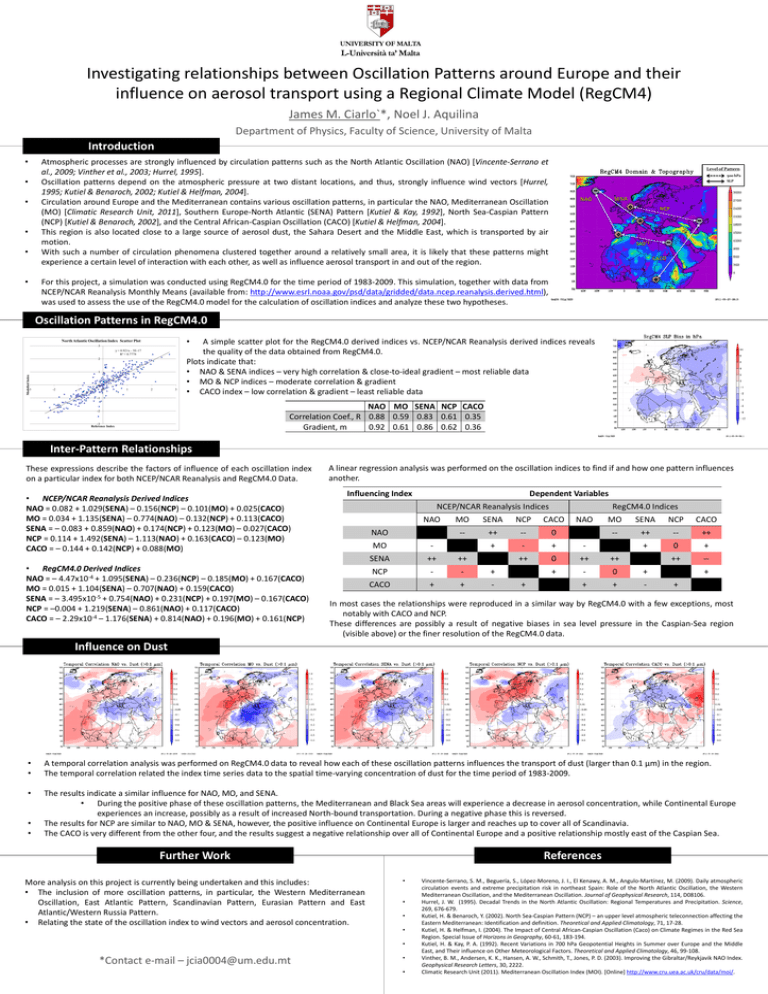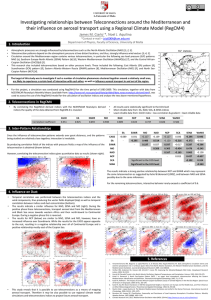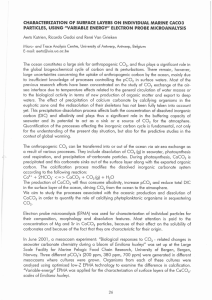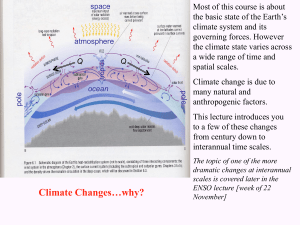Investigating relationships between Oscillation Patterns around Europe and their
advertisement

Investigating relationships between Oscillation Patterns around Europe and their influence on aerosol transport using a Regional Climate Model (RegCM4) James M. Ciarlo`*, Noel J. Aquilina Department of Physics, Faculty of Science, University of Malta Introduction • • • • • • Atmospheric processes are strongly influenced by circulation patterns such as the North Atlantic Oscillation (NAO) [Vincente-Serrano et al., 2009; Vinther et al., 2003; Hurrel, 1995]. Oscillation patterns depend on the atmospheric pressure at two distant locations, and thus, strongly influence wind vectors [Hurrel, 1995; Kutiel & Benaroch, 2002; Kutiel & Helfman, 2004]. Circulation around Europe and the Mediterranean contains various oscillation patterns, in particular the NAO, Mediterranean Oscillation (MO) [Climatic Research Unit, 2011], Southern Europe-North Atlantic (SENA) Pattern [Kutiel & Kay, 1992], North Sea-Caspian Pattern (NCP) [Kutiel & Benaroch, 2002], and the Central African-Caspian Oscillation (CACO) [Kutiel & Helfman, 2004]. This region is also located close to a large source of aerosol dust, the Sahara Desert and the Middle East, which is transported by air motion. With such a number of circulation phenomena clustered together around a relatively small area, it is likely that these patterns might experience a certain level of interaction with each other, as well as influence aerosol transport in and out of the region. Level of Pattern 500 hPa SLP For this project, a simulation was conducted using RegCM4.0 for the time period of 1983-2009. This simulation, together with data from NCEP/NCAR Reanalysis Monthly Means (available from: http://www.esrl.noaa.gov/psd/data/gridded/data.ncep.reanalysis.derived.html), was used to assess the use of the RegCM4.0 model for the calculation of oscillation indices and analyze these two hypotheses. Oscillation Patterns in RegCM4.0 • North Atlantic Oscillation Index Scatter Plot 3 y = 0.921x - 5E-17 R² = 0.7778 2 Modelled Index 1 -3 0 -2 -1 0 1 2 3 A simple scatter plot for the RegCM4.0 derived indices vs. NCEP/NCAR Reanalysis derived indices reveals the quality of the data obtained from RegCM4.0. Plots indicate that: • NAO & SENA indices – very high correlation & close-to-ideal gradient – most reliable data • MO & NCP indices – moderate correlation & gradient • CACO index – low correlation & gradient – least reliable data -1 NAO MO SENA NCP CACO Correlation Coef., R 0.88 0.59 0.83 0.61 0.35 Gradient, m 0.92 0.61 0.86 0.62 0.36 -2 -3 Reference Index Inter-Pattern Relationships These expressions describe the factors of influence of each oscillation index on a particular index for both NCEP/NCAR Reanalysis and RegCM4.0 Data. • NCEP/NCAR Reanalysis Derived Indices NAO = 0.082 + 1.029(SENA) – 0.156(NCP) – 0.101(MO) + 0.025(CACO) MO = 0.034 + 1.135(SENA) – 0.774(NAO) – 0.132(NCP) + 0.113(CACO) SENA = – 0.083 + 0.859(NAO) + 0.174(NCP) + 0.123(MO) – 0.027(CACO) NCP = 0.114 + 1.492(SENA) – 1.113(NAO) + 0.163(CACO) – 0.123(MO) CACO = – 0.144 + 0.142(NCP) + 0.088(MO) • RegCM4.0 Derived Indices NAO = – 4.47x10-4 + 1.095(SENA) – 0.236(NCP) – 0.185(MO) + 0.167(CACO) MO = 0.015 + 1.104(SENA) – 0.707(NAO) + 0.159(CACO) SENA = – 3.495x10-5 + 0.754(NAO) + 0.231(NCP) + 0.197(MO) – 0.167(CACO) NCP = –0.004 + 1.219(SENA) – 0.861(NAO) + 0.117(CACO) CACO = – 2.29x10-4 – 1.176(SENA) + 0.814(NAO) + 0.196(MO) + 0.161(NCP) A linear regression analysis was performed on the oscillation indices to find if and how one pattern influences another. Influencing Index Dependent Variables NCEP/NCAR Reanalysis Indices NAO NAO RegCM4.0 Indices MO SENA NCP CACO -- ++ -- 0 + - + - ++ 0 ++ ++ + - 0 + + + - MO - SENA ++ ++ NCP - - + CACO + + - + NAO MO SENA NCP CACO -- ++ -- ++ + 0 + ++ -+ + In most cases the relationships were reproduced in a similar way by RegCM4.0 with a few exceptions, most notably with CACO and NCP. These differences are possibly a result of negative biases in sea level pressure in the Caspian-Sea region (visible above) or the finer resolution of the RegCM4.0 data. Influence on Dust • • A temporal correlation analysis was performed on RegCM4.0 data to reveal how each of these oscillation patterns influences the transport of dust (larger than 0.1 μm) in the region. The temporal correlation related the index time series data to the spatial time-varying concentration of dust for the time period of 1983-2009. • The results indicate a similar influence for NAO, MO, and SENA. • During the positive phase of these oscillation patterns, the Mediterranean and Black Sea areas will experience a decrease in aerosol concentration, while Continental Europe experiences an increase, possibly as a result of increased North-bound transportation. During a negative phase this is reversed. The results for NCP are similar to NAO, MO & SENA, however, the positive influence on Continental Europe is larger and reaches up to cover all of Scandinavia. The CACO is very different from the other four, and the results suggest a negative relationship over all of Continental Europe and a positive relationship mostly east of the Caspian Sea. • • Further Work More analysis on this project is currently being undertaken and this includes: • The inclusion of more oscillation patterns, in particular, the Western Mediterranean Oscillation, East Atlantic Pattern, Scandinavian Pattern, Eurasian Pattern and East Atlantic/Western Russia Pattern. • Relating the state of the oscillation index to wind vectors and aerosol concentration. References • • • • • *Contact e-mail – jcia0004@um.edu.mt • • Vincente-Serrano, S. M., Beguería, S., López-Moreno, J. I., El Kenawy, A. M., Angulo-Martínez, M. (2009). Daily atmospheric circulation events and extreme precipitation risk in northeast Spain: Role of the North Atlantic Oscillation, the Western Mediterranean Oscillation, and the Mediterranean Oscillation. Journal of Geophysical Research, 114, D08106. Hurrel, J. W. (1995). Decadal Trends in the North Atlantic Oscillation: Regional Temperatures and Precipitation. Science, 269, 676-679. Kutiel, H. & Benaroch, Y. (2002). North Sea-Caspian Pattern (NCP) – an upper level atmospheric teleconnection affecting the Eastern Mediterranean: Identification and definition. Theoretical and Applied Climatology, 71, 17-28. Kutiel, H. & Helfman, I. (2004). The Impact of Central African-Caspian Oscillation (Caco) on Climate Regimes in the Red Sea Region. Special Issue of Horizons in Geography, 60-61, 183-194. Kutiel, H. & Kay, P. A. (1992). Recent Variations in 700 hPa Geopotential Heights in Summer over Europe and the Middle East, and Their influence on Other Meteorological Factors. Theoretical and Applied Climatology, 46, 99-108. Vinther, B. M., Andersen, K. K., Hansen, A. W., Schmith, T., Jones, P. D. (2003). Improving the Gibraltar/Reykjavik NAO Index. Geophysical Research Letters, 30, 2222. Climatic Research Unit (2011). Mediterranean Oscillation Index (MOI). [Online] http://www.cru.uea.ac.uk/cru/data/moi/.




